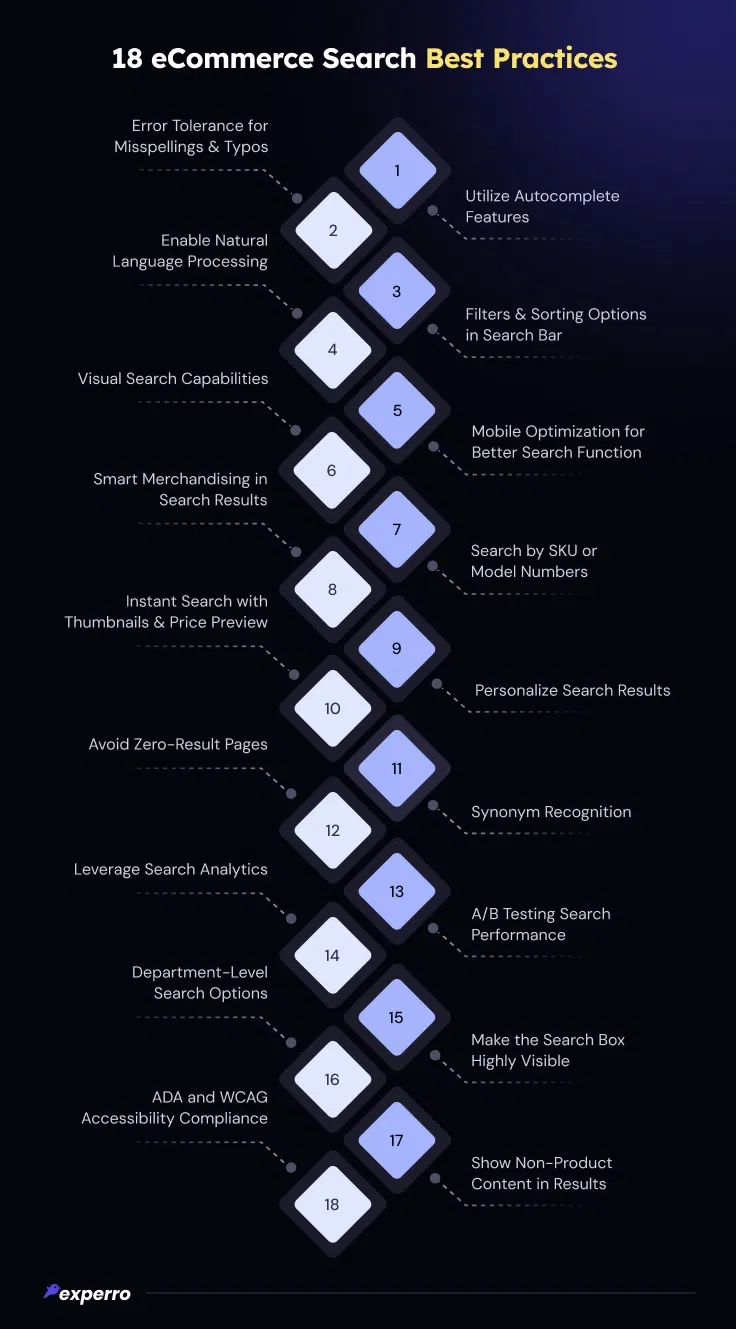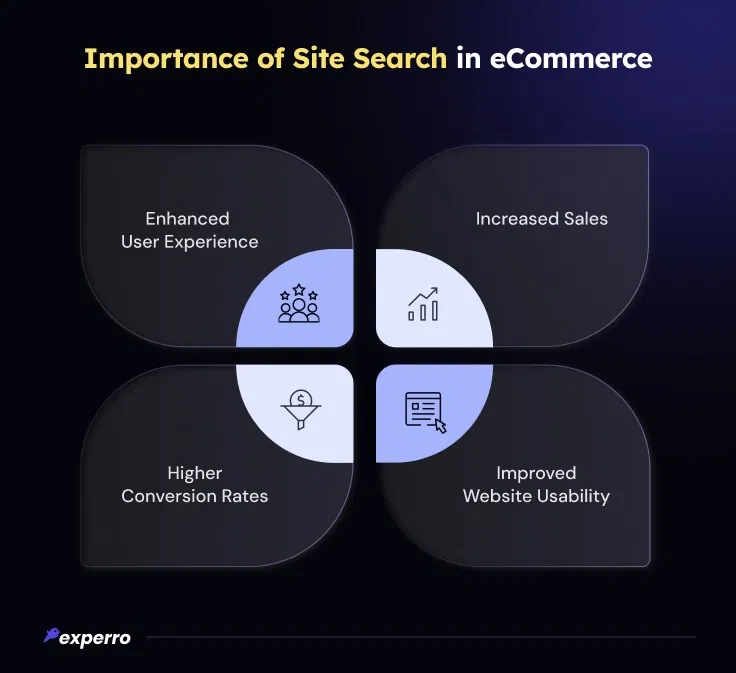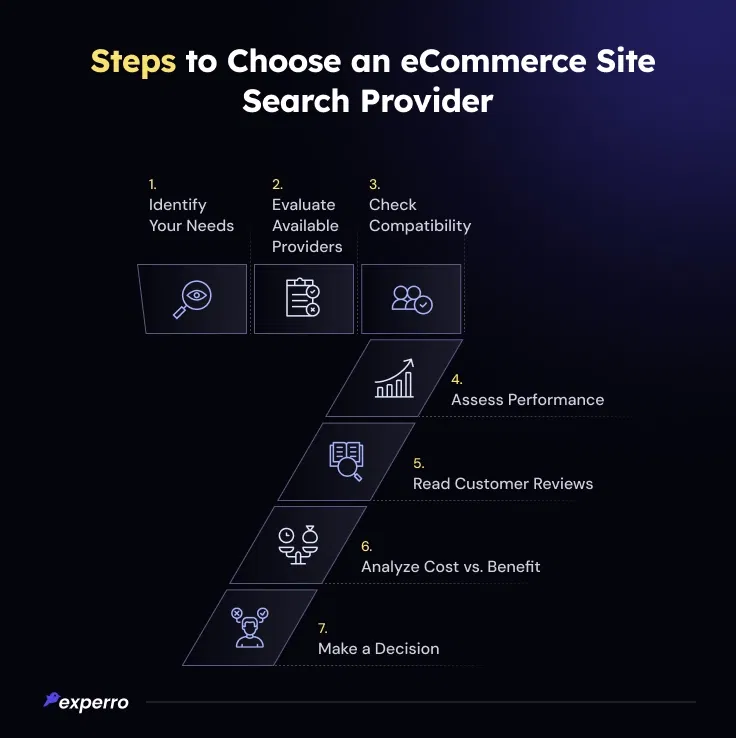18 eCommerce Search Best Practices Before This Quarter Ends!

What’s Inside
- What Are the 18 eCommerce Search Best Practices?
Experro Search vs Algolia Search!
- Why Site Search Is Critical for eCommerce Success in 2025?
- How to Choose an eCommerce Site Search Provider?
- Why Is Experro the Perfect Choice for eCommerce Site Search Experience?
- Conclusion
Key Takeaways
- Optimizing eCommerce search best practices enhances user experience and significantly boosts eCommerce conversions.
- Implementing advanced features like search autocomplete and natural language processing improves search efficiency.
- Visual and voice search capabilities are essential for modern eCommerce platforms to meet diverse user needs.
- Experro's AI-driven search technology delivers personalized and relevant search results, elevating eCommerce success.
Do you run an eCommerce store with 1000s—or even 100000s—of products listed on your site? If so, you already know how challenging it can be to help customers find exactly what they’re looking for.
Without a well-organized product taxonomy and a smart on-site search, even your best products can get buried.
By implementing best practices in eCommerce site search, you can transform a simple search bar UI into a powerful asset. This enhancement boosts customer satisfaction increases sales and reduces bounce rates.
In this guide, we’ll explore practical eCommerce search best practices to help your customers discover products faster, improve their experience, and drive more sales—no matter how much headache your product catalog management gives you.
From understanding eCommerce search best practices to implementing on-site search best practices, this guide will cover essential practices to enhance your site’s performance.
What Are the 18 eCommerce Search Best Practices?

To thrive in the competitive digital marketplace, it's essential to optimize the eCommerce site search best practices. You can treat these as the elements of eCommerce search checklist. Here they are:
1. Utilize Autocomplete Features

One of the most effective eCommerce search best practices is implementing autocomplete. It guides users toward products with minimal effort.
When shoppers begin typing, real-time suggestions appear. These are based on popular search terms, titles, or categories.
This reduces search time and helps users discover more items. It also keeps users engaged and lowers bounce rates.
Among eCommerce site search best practices, autocomplete helps with long-tail queries and spelling variations.
It makes internal site search more responsive. And it supports essential search functionality in eCommerce.
2. Error Tolerance for Misspellings and Typos

Shoppers often type queries with errors. One of the key eCommerce search best practices is to detect and fix these mistakes automatically.
For instance, if someone types "niks shoes" instead of "Nike shoes", they should still get accurate results.
This prevents zero-result pages and improves eCommerce search results pages significantly.
Fuzzy matching and phonetic recognition support this. It's a best practice in eCommerce site search and helps conversions.
3. Filters and Sorting Options in Search Bar

Filters and sorting options give users control over search results. This is critical for stores with large product catalogs.
Users can refine results by brand, price, size, or color. This reduces decision fatigue and helps shoppers act faster.
Integrating eCommerce filters into your search is part of top onsite search best practices. It aligns with on-site search best practices.
It also improves internal search ROI and user satisfaction.
4. Enable Natural Language Processing

Natural Language Processing (NLP) helps your eCommerce internal search understand user intent.
It moves beyond keywords and focuses on context. For example, "running shoes under $100" should show filtered results even without a price filter.
This approach is vital in eCommerce search best practices. It turns your site into a smarter discovery engine.
NLP supports search functionality in eCommerce that feels natural and human-like.
5. Mobile Optimization for Better Search Function
More users shop on mobile now. So, following mobile search best practices is essential for mobile eCommerce search best practices.
Your search bar should be responsive and easy to tap. Filters should work well with touch.
Mobile search should be fast and lightweight. This is one of the leading eCommerce site search best practices today.
It reduces friction and improves the search experience on small screens.
6. Visual Search Capabilities

Visual search is gaining popularity. It's one of the newest eCommerce search best practices for image-heavy categories.
Users can upload an image to find similar products. This removes the need to know exact product names.
It improves discovery when shoppers don’t know what to type. Visual search supports eCommerce site search best practices for mobile-first browsing.
It also enhances eCommerce internal search by enabling inspiration-based exploration.
7. Search by SKU or Model Numbers
Many repeat buyers prefer using SKUs or model numbers. Supporting this is a crucial eCommerce search best practice.
It enables exact-match search. This is particularly useful in B2B or electronics eCommerce.
By optimizing your product search algorithm for SKU-based searches, you can enhance eCommerce search results pages. It also aligns with eCommerce site best practices for precision and speed.
8. Smart Merchandising in Search Results
Search can be a powerful marketing tool. One of the smartest eCommerce search best practices is to use merchandising rules in search results.
Promote seasonal items, trending products, or high-margin SKUs. Use some Valentine's day eCommerce strategies for the best results.
This turns your search into a dynamic sales channel. It supports eCommerce site search history–driven merchandising strategies.
It's a great way to increase average order value from internal searches.
9. Personalize Search Results
Search personalization tailors results to each user. It is one of the most effective eCommerce search best practices for improving relevance.
Use past behavior, purchase history, or preferences. This leads to faster decisions and better user experiences.
It also helps eCommerce internal search feel intelligent. It reflects top best practices for site search used by leading brands.
10. Instant Search with Thumbnails and Price Preview
Instant search shows results as users type. Including images and prices makes it more useful and engaging.
This approach improves eCommerce homepage best practices. It shortens the path to purchase and increases click-throughs.
It’s one of the eCommerce search best practices that boosts ROI from your search box.
11. Synonym Recognition
Customers use different words for the same products. Recognizing synonyms is a key eCommerce search best practice.
It ensures your eCommerce search results pages show highly relevant items, improving search relevance even when different search terms are used.
It bridges the gap between brand and shopper vocabulary. It's also part of solid internal site search best practices.
12. Avoid Zero-Result Pages
Zero results kill conversions. A key eCommerce site search best practice is to avoid them at all costs.
Show related items, spelling fixes, or popular products instead. This keeps the session alive and helps with discovery.
It also uses eCommerce site search history to improve future results. This aligns well with website search best practices.
13. A/B Testing Search Performance
Testing is critical for continuous improvement. A/B tests help refine eCommerce search best practices based on real data.
Test layouts, ranking logic, or autocomplete behavior. See what drives higher engagement or conversions.
This supports eCommerce site best practices by evolving your search strategy over time.
14. Leverage Search Analytics
Use analytics to study what users search for. It reveals intent, drop-offs, and missed opportunities.
This insight improves your eCommerce internal search and helps tune ecommerce search results pages.
It’s one of the eCommerce search best practices that delivers better ROI over time. It also improves website search box ROI.
15. Make the Search Box Highly Visible
If users can’t find your search bar, they can’t use it. Make it easy to see and use across all pages.
This is one of the basic yet critical eCommerce search best practices. It improves user flow and satisfaction.
Following search box best practices ensures your eCommerce internal search is actually used.
16. Department-Level Search Options
Let users search within a category or department. It improves result accuracy and reduces noise.
This is a vital eCommerce site search best practice for large catalogs. It makes internal search more intuitive.
It’s especially useful in online retail site search best practices where categories are diverse.
17. Show Non-Product Content in Results
Not all queries are product-related. Some users want FAQs, policies, or blogs.
Include non-product content in your results. This is a modern eCommerce search best practice.
It adds depth to eCommerce search results pages. It also supports better search functionality in eCommerce.
18. ADA and WCAG Accessibility Compliance
Search must be inclusive. Compliance with ADA and WCAG ensures everyone can use it.
Make sure it works with screen readers and keyboard navigation. This is a forward-thinking eCommerce site search best practice.
It reflects strong eCommerce best practices and builds trust across all user types.
Thus, these were the top practices in eCommerce search.
Imagine the growth ahead if by 2027, eCommerce's search industry segment is predicted to hit a $8 trillion mark!
Experro Search vs Algolia Search!
See how Experro outperforms Algolia (an over-hyped search provider) with GEN-AI based smarter search technology that drive conversions!
Why Site Search Is Critical for eCommerce Success in 2025?

Creating an efficient site search experience is crucial for any eCommerce website.
It significantly enhances user experience, boosts sales, improves eCommerce store usability, and leads to higher conversion rates.
Here, we explore these aspects in detail:
1. Enhanced User Experience
A well-optimized site search provides a seamless and intuitive way for site visitors to find the exact results of what they're looking for. It significantly enhances their overall experience on your website.
Implementing eCommerce site best practices, such as using auto-complete, correcting misspellings, providing relevant filters, and enabling multimodal search, can actually lead to a more satisfying user journey.
2. Increased Sales
Effective site search plays a crucial role in boosting sales.
When a search function accurately interprets user intent and delivers precisely what shoppers are searching for, it naturally leads to increased purchases, directly enhancing the bottom line.
3. Improved Website Usability
Website usability is significantly improved when users can easily navigate and use the site search box without confusion or difficulty.
These strategies not only help in maintaining a clean and efficient user interface but also support users in using eCommerce websites with greater ease and confidence.
4. Higher Conversion Rates
A direct correlation exists between effective site search and higher conversion rates.
By implementing on-site eCommerce search best practices, eCommerce sites can significantly improve their conversion rates. This includes optimizing onsite search result page load times and ensuring mobile responsiveness.
How to Choose an eCommerce Site Search Provider?
Creating an effective eCommerce site search experience is crucial for boosting user engagement and conversions.

Below is a detailed guide on how to choose the right eCommerce site search provider.
1. Identify Your Needs
Before diving into the selection process, clearly outline what you expect from your site search functionality.
Consider factors like the size of your product catalog, the complexity of your product attributes, and specific features you might need, such as eCommerce search autocomplete, synonyms handling, and custom filtering.
Understanding your specific requirements will guide you in choosing a provider that aligns with eCommerce search best practices.
2. Evaluate Available Providers
Research and compile a list of potential site search platforms. Look for those that consistently adhere to eCommerce site search best practices, including high relevancy of search results, and scalability.
All the tools that integrate advanced technologies like AI and machine learning should be considered as they can significantly enhance search accuracy and user experience.
3. Check Compatibility
Ensure that the site search solution is compatible with your eCommerce platform. Compatibility is crucial for seamless integration and operation.
The provider should support easy integration with your existing systems, including headless CMS approach, ERP, and eCommerce platforms, ensuring adherence to website search best practices.
4. Assess Performance
Performance is a key indicator of a good search provider. Fast, accurate, and relevant search results are fundamental to eCommerce search best practices.
Evaluate the speed of generative AI search results, accuracy in fetching relevant products, and the effectiveness of query handling.
Performance can be assessed through demos, free trials, or reading up on technology stacks used by the provider.
5. Read Customer Reviews
Customer reviews are invaluable for understanding the reliability and effectiveness of a search provider.
Look for feedback about customer support, ease of use, and the actual impact on sales and customer satisfaction. Reviews can provide practical insights into whether providers follow eCommerce search best practices.
6. Analyze Cost vs. Competitive Advantage
Analyze the cost of implementing a good site search solution against the potential benefits. Consider both direct costs like licensing fees, and indirect costs such as implementation time and resources.
It improves user experience and increases conversion rates, aligning with eCommerce site search best practices.
7. Make a Decision
After thorough research and evaluation, select the site search platform that best meets your needs and aligns with eCommerce best practices.
The chosen solution should not only fit your current requirements but also be scalable to adapt to future business growth and changes in technology.
Why Is Experro the Perfect Choice for eCommerce Site Search Experience?
Experro is the perfect choice for your eCommerce site search because it uses AI to enhance user experiences.
It uses advanced algorithms to make search results relevant and personalized results, following eCommerce search best practices.
This is key for boosting user engagement and sales. Experro's AI also learns from user actions to keep improving search results. This keeps your platform up-to-date and efficient, which is essential for staying competitive.
Key features that make Experro an exceptional choice include:
- AI-Powered Search: Experro uses artificial intelligence to refine search results, ensuring higher relevance and catering to individual user needs.
- eCommerce Merchandising: With merchandising capabilities, Experro allows you to strategically showcase products.
- Seamless Integration: The platform's architecture for easy integration with existing eCommerce systems is the best commitment to eCommerce search best practices.
- Scalability: Experro meets on-site search best practices as your business scales. It is adaptable to growing business needs and expanding product ranges.
By choosing Experro, you ensure that your eCommerce site not only meets but exceeds the modern standards of site search efficiency and effectiveness.
Conclusion
In conclusion, following eCommerce site search best practices is not just about improving search functionality.
It is about transforming user experience, boosting conversion rates, and ensuring operational excellence.
By choosing a site search platform that aligns with these principles, you position your eCommerce platform to rank in a competitive market.
Effective site search streamlines the customer experience, making it faster and more intuitive. Therefore, when you adhere to these practices in your eCommerce site, you set the stage for sustained growth and success in the digital marketplace.
Stay tuned to learn more or schedule a call with us!
FAQs


Pallavi Dadhich
24 December 2024Pallavi is an ambitious author known for her expertise in crafting compelling content across various domains. Beyond her professional pursuits, Pallavi is deeply passionate about continuous learning, often immersing herself in the latest industry trends. When not weaving words, she dedicates her time to mastering graphic design.